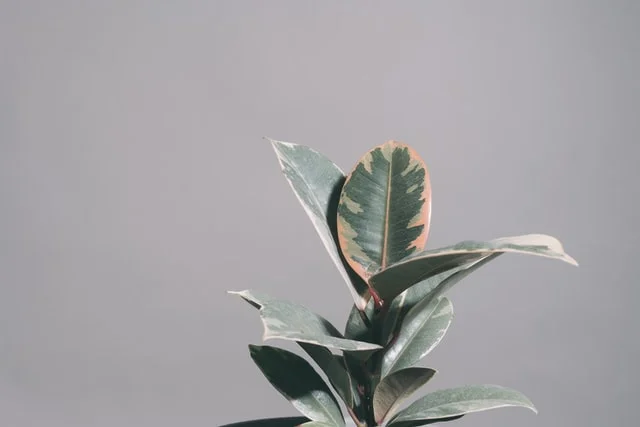Table of Contents
Caring for Variegated Rubber Plants
The variegated rubber plant, also known as a variegated rubber tree, has variations called Ficus elastica tineke and Ficus Elastica Ruby. All of these are the same thing:
Rubber plants with color variation on the leaves, from dark green to whiteish yellow, with either hints of pink (tineke) or brightly pink (Ruby) edges and stems.
The variegated foliage makes this a sought after plant, especially since, like most rubber plants, the variegated rubber plant is a relatively hardy houseplant that enjoys conditions fairly similar to most household conditions.
Though originally from Southeast Asia, this plant has found popularity over much of the world.
Variegated rubber plants are grown for their beautifully colored leaves, not for flowers.
Helping Your Variegated Rubber Plant Thrive
As with all plants, the variegated rubber plant has conditions under which it thrives rather than just surviving.
The variegated rubber plant likes temperatures to range from average to warm, with a preference for similar average to high humidity.
It needs soil that is moist but not wet, and it likes light that is bright but not too direct. If you’re new to being a plant parent, this may seem like a lot, but it’s really easy to maintain once you get the hang of it.
The variegated rubber plant is easy to moderate in its care needs. It can survive in most household settings as long as it has the right amount of water, but the following tips will help you keep the plant happy.
Light Requirements
The variegated rubber plant does best in bright, indirect light. Most rubber plants like their light a little bit lower, at more of a medium light level, but any variegated plant tends to need a little bit more light in order to really show off its coloring.
If the leaves start getting less variation or turning more of a dark green, your variegated rubber plant might not be getting enough light.
Be sure to avoid direct light, especially in summer or in places with hot sun, because this can scorch the leaves.
Temperature Requirements
The variegated rubber plant likes temperatures that range from 60 degrees Fahrenheit to 80 degrees Fahrenheit, which makes them pretty compatible with most household temperatures.
Be sure to avoid letting the temperature drop below 55 degrees. Also avoid placing the plant too near an air vent, since ficus plants don’t always handle drafts well.
Soil Requirements
The variegated rubber plant should have soil that is well-draining. This means you’ll probably want perlite or small rocks to help the soil drain and help keep it from staying too wet.
Be sure that its pot has adequate drainage and that nothing blocks the drainage hole(s).
Humidity Requirements
The variegated rubber plant does fine in average humidity. It prefers a little higher humidity rather than humidity that’s too low, so if you live in a dry climate, consider either using nearby water to increase ambient humidity or investing in a humidifier.
Brown spots on the leaves can indicate that the plant needs a little more humidity.
How to Water Your Variegated Rubber Plant
The variegated rubber plant should be watered approximately once a week, but that can vary fairly significantly based on climate and season.
Generally, in average humidity, this plant should be watered every 5-7 days in summer and every 10-14 days in winter.
To know when it’s time to water the variegated rubber plant, check the top inch or two of soil. If it’s dry, you can go ahead and water it. If it’s still fairly moist, hold off. Many plants are sensitive to overwatering, and the rubber plant is no exception.
If the leaves start turning a washed-out yellow and drooping, it may be receiving too much water.
How to Fertilize Your Variegated Rubber Plant
Fertilize the variegated rubber plant using a balanced fertilizer diluted by half, once a month during spring and summer. Your plant shouldn’t need fertilizing during winter.
If the leaves start looking burnt at the edges, this may be a result of too much fertilization. Try diluting fertilizer even more or cutting back how often it’s applied.
Pruning Your Variegated Rubber Plant
The variegated rubber plant can be pruned as needed for size, and also to help give the plant a fuller, more leafy appearance.
The plant’s appearance can also benefit from regular wiping of leaves with a soft, dry or damp cloth to wipe off any dust buildup.
Propagation of Your Variegated Rubber Plant
Rubber plants do best when propagated by cutting. This is best done during the growing seasons. Take a cutting, clipping an inch or two before where a leaf meets stem, and then plant the cutting, with the cut stem in soil.
Give it extra love until it takes root, making sure it stays moist without drowning it and giving it plenty of heat and humidity.
Be aware that the rubber plant releases a milky sap when cut, and this can be a significant skin irritant, so it’s a good idea to watch for that or to wear gloves.
Pests and Diseases
The variegated rubber plant isn’t particularly prone to diseases. It does have a good leaf size to attract common pests. If the leaves start looking dull or silvery, check for pests.
Ridding Your Variegated Rubber Plant of Pests
Clean off any signs of infestation manually. Look particularly under the leaves, nearest the stem. Then, apply a gentle insecticide or neem oil.
If you see any thrips, you’ll also want to replace the top couple inches of soil or repot the plant entirely, since thrips lay their eggs in the soil.
Be aware that repotting the plant if it’s recovering from an infestation can be risky, so this is an area where playing it safe may mean only replacing the top parts of the soil.
Toxicity
This plant is mildly toxic to humans and pets and can cause skin and stomach irritation, as well as vomiting if consumed.
If you have sensitive skin or are planning to have prolonged contact with the plant, such as during pruning, consider wearing gloves.
Quick Reference
- Light: Bright and indirect
- Temperature: 60-80 degrees Fahrenheit
- Soil: Well-draining soil
- Humidity: Average to high
- Water: Every 5-14 days or when top 1-2 inches of soil is dry
- Pruning: As needed for size and aesthetics
Photo by Scott Webb on Unsplash



